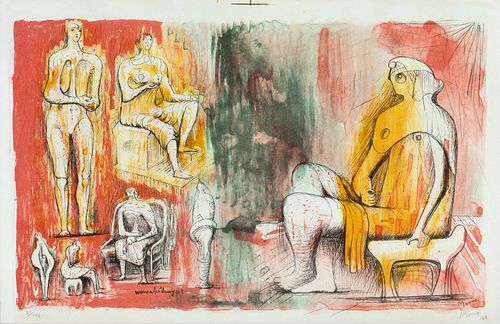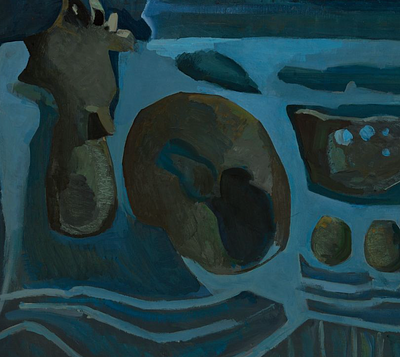HENRY MOORE (United Kingdom, 1898 - 1986). "Woman holding cat," 1949. Color lithograph on paper, copy 21/75.
Lot 86
About Seller
Setdart Auction House
Carrer Aragó 346
Barcelona
Spain
Setdart Subastas was born in 2004 and is currently the first online art auction in Spain with solidity, prestige and reliability guaranteed by our more than 60,000 users. Setdart has a young, dynamic and enterprising team ready to successfully manage the purchase and sale of art works through custom...Read more
Categories
Estimate:
EUR€8,000 - EUR€9,000
$8,602.15 - $9,677.42
Absentee vs Live bid
Two ways to bid:
- Leave a max absentee bid and the platform will bid on your behalf up to your maximum bid during the live auction.
- Bid live during the auction and your bids will be submitted real-time to the auctioneer.
Bid Increments
| Price | Bid Increment |
|---|---|
| EUR€0 | EUR€10 |
| EUR€200 | EUR€25 |
| EUR€500 | EUR€50 |
| EUR€1,000 | EUR€100 |
| EUR€3,000 | EUR€200 |
| EUR€5,000 | EUR€500 |
| EUR€10,000 | EUR€1,000 |
| EUR€20,000 | EUR€2,000 |
| EUR€50,000 | EUR€5,000 |
About Auction
By Setdart Auction House
Jul 27, 2021
Set Reminder
2021-07-27 08:00:00
2021-07-27 08:00:00
America/New_York
Bidsquare
Bidsquare : CONTEMPORARY AND ACTUAL ART
https://www.bidsquare.com/auctions/setdart-auction-house/contemporary-and-actual-art-7261
Setdart Auction House sofia@setdart.com
Setdart Auction House sofia@setdart.com
- Lot Description
HENRY MOORE (United Kingdom, 1898 - 1986). "Woman holding cat," 1949. Color lithograph on paper, copy 21/75. Signed, dated and hand justified by the author. Titled and signed in plate. Printed by Ganymed Press Ltd. Published by Ganymed Original Editions, Ltd., London. Modernist marquetry frame with geometric ornaments. Size: 33 x 53 cm; 61.5 x 74 cm (frame). Although Henry Moore was known mainly for his work as a sculptor, it is inevitable to note the link he professed for the field of lithography, in which he relied for the printing of numerous works. The work in question, which shows a female figure arranged in different positions, reflects Moore's creative process: before creating each sculpture, he made several sketches and drawings that were works of art in themselves. Henry Moore trained at the Leeds School of Art and the Royal College of Art in London. Although during his early years he followed the Romantic style of the Victorian era, he gradually developed his own language, influenced by Italian Renaissance artists such as Giotto, Giovanni Pisano and Michelangelo, and also by the sculpture of the Toltec-Maya culture. His early works of the 1920s also show a certain influence of the aerodynamic forms of Constantin Brancusi. During the following decade his work would be influenced by Picasso and the avant-garde abstract artists, both in his drawings and sculptures. Thus, many of his works of this period approach abstraction, some of them being rounded pieces carved in wood, with numerous cuts and holes, often covered by veils of fine metal wire. However, Moore's main and most permanent influence came from the world of nature. In his mature period, beginning with "Reclining Figure" (1936, City Art Gallery, Wakefield), Moore would employ swollen, rotund, undulating forms, with rounded hollows and perforations reflecting natural forms. His favorite subjects, from this point on, include mothers with their children, family groups, fallen warriors and, above all, the reclining human figure, which he continued to depict throughout his career, whether worked in wood or stone or, from 1950, in bronze and marble. In 1955 he received the Order of the Companions of Honor, and the Order of Merit in 1963. He was also a member of the boards of the National Gallery in London and the Tate. Moore is currently represented in the most important museums around the world, such as the MoMA in New York, where a retrospective was dedicated to him in 1946; the Thyssen-Bornemisza in Madrid, the National Gallery and the Tate in London, the Metropolitan in New York, the Peggy Guggenheim Collection in Venice, etc.
- Shipping Info
-
In-house shipping available. Please inquire at admin@setdart.com.
-
- Buyer's Premium



 EUR
EUR CAD
CAD AUD
AUD GBP
GBP MXN
MXN HKD
HKD CNY
CNY MYR
MYR SEK
SEK SGD
SGD CHF
CHF THB
THB














